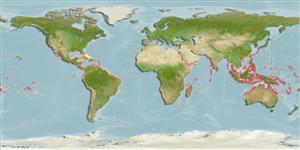Klassifizierung / Names
Namen | Synonyme | Catalog of Fishes(Gattung, Arten) | ITIS | CoL | WoRMS | Cloffa
Environment: milieu / climate zone / depth range / distribution range
Ökologie
seewasser riff-verbunden; standorttreu; tiefenbereich 1 - 5 m (Ref. 7247). Tropical; 30°N - 30°S
Indo-Pacific: Red Sea and East African coast to the Line and Society Islands, north to the Ryukyu and Bonin Islands, south to New Caledonia and Tonga; throughout Micronesia.
Size / Gewicht / Alter
Maturity: Lm ? range ? - ? cm
Max length : 13.0 cm SL Männchen/unbestimmt; (Ref. 7247)
Rückenflossenstacheln (insgesamt) : 12; Rückenflossenweichstrahlen (insgesamt) : 14 - 16; Afterflossenstacheln: 2; Afterflossenweichstrahlen: 12 - 14.
A territorial species commonly found in coral reef areas with dead staghorn corals. Adults feed on filamentous algae supported by these dead corals. Frequently charge human intruders without hesitation, sometimes taking painful nips which are mildly alarming when unexpected. Particularly aggressive during reproductive periods. They emit a clicking noise during aggressive encounters. Act aggressively toward most herbivorous fishes and some other fishes; defend its territory for feeding advantages (Ref. 47011). Oviparous, distinct pairing during breeding (Ref. 205). Eggs are demersal and adhere to the substrate (Ref. 205). Males guard and aerate the eggs (Ref. 205).
Life cycle and mating behavior
Geschlechtsreife | Fortpflanzung | Ablaichen | Eier | Fecundity | Larven
Oviparous, distinct pairing during breeding (Ref. 205). Eggs are demersal and adhere to the substrate (Ref. 205). Males guard and aerate the eggs (Ref. 205).
Allen, G.R. and A.R. Emery, 1985. A review of the Pomacentrid fishes of the genus Stegastes from the Indo-Pacific, with descriptions of two new species. Indo-Pac. Fish. (3):31. (Ref. 510)
IUCN Rote Liste Status (Ref. 130435: Version 2024-2)
Nutzung durch Menschen
Fischereien: weniger kommerziell
Tools
Zusatzinformationen
Download XML
Internet Quellen
Estimates based on models
Preferred temperature (Ref.
123201): 25.5 - 29.3, mean 28.2 °C (based on 3835 cells).
Phylogenetic diversity index (Ref.
82804): PD
50 = 0.5000 [Uniqueness, from 0.5 = low to 2.0 = high].
Bayesian length-weight: a=0.02344 (0.01401 - 0.03921), b=2.96 (2.82 - 3.10), in cm total length, based on LWR estimates for this species & Genus-body shape (Ref.
93245).
Trophic level (Ref.
69278): 2.0 ±0.0 se; based on diet studies.
Widerstandsfähigkeit (Ref.
120179): hoch, Verdopplung der Population dauert weniger als 15 Monate. (Preliminary K or Fecundity.).
Fishing Vulnerability (Ref.
59153): Low vulnerability (10 of 100).
Nutrients (Ref.
124155): Calcium = 110 [53, 187] mg/100g; Iron = 0.749 [0.436, 1.329] mg/100g; Protein = 18 [17, 19] %; Omega3 = 0.0853 [, ] g/100g; Selenium = 17.6 [9.1, 37.6] μg/100g; VitaminA = 82.6 [19.0, 332.3] μg/100g; Zinc = 2.05 [1.33, 3.17] mg/100g (wet weight);
